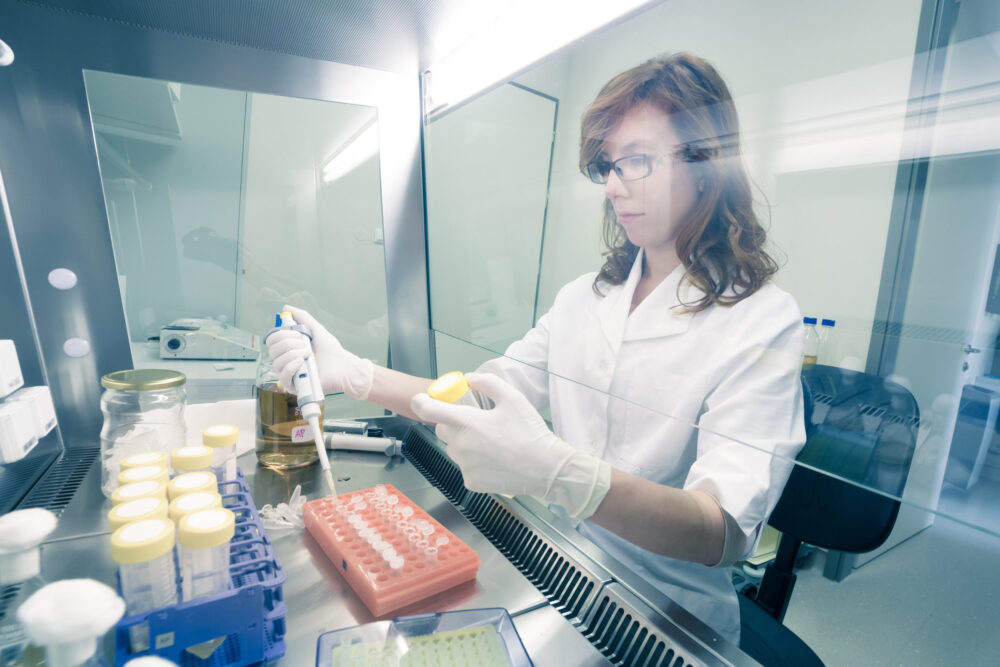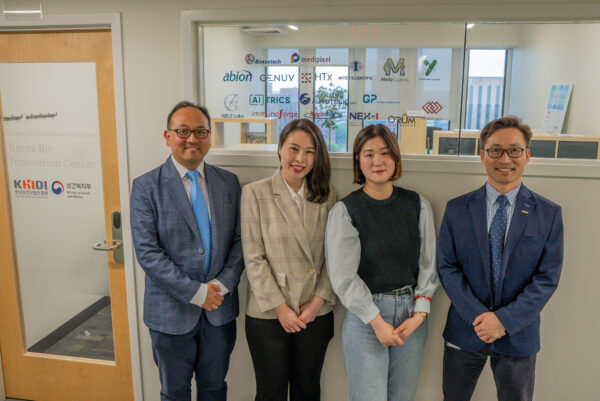Carbon emissions. Deforestation. Plastic pollution. Overfishing. The planet faces myriad stressors that researchers, advocates and activists, and everyday communities alike are increasingly concerned about. Amidst the concern is a search for solutions.
In celebration of Earth Day, we shine the spotlight on four sustainability companies at CIC that are enacting solutions to environmental challenges both locally and globally:
1. SeaAhead – Boston, MA
It’s easy to find a coworking space nowadays. But finding a coworking space with the right community to propel your business can be more challenging, especially when you’re in the business of oyster farming or offshore wind energy. Companies that fall under the banner of bluetech — innovation targeted at ocean industries or sustainability — often have unique interests and needs that aren’t shared by the average urban coworking member.
“One of the things we’ve heard is that they didn’t necessarily feel like the people around them understood what they were doing or had a lot in common,” says Alissa Peterson, cofounder and executive director of SeaAhead, headquartered at CIC Boston.
In January 2019, sustainability company SeaAhead opened a coworking space in partnership CIC specifically dedicated to ocean innovation companies. “We believe in the fortuitous thing that happens when folks are near each other and have the opportunity to meet,” says Peterson.
Though originally from Providence, Rhode Island, the SeaAhead founding team decided to set up in Boston because of its centrality — both geographically within New England and as a tech and venture capital hub. “There are a lot of entrepreneurs spread around the coastal community, and we wanted to give them the access they need to corporations, to investors, and to talent coming out of Boston’s universities,” says Peterson.
Bluetech is a relatively new term, but it represents major opportunities for commercialization and, simultaneously, positive environmental impact. And in today’s world, both are needed, according to Peterson. “We are unlikely to cause scaleable change if we focus on what people can no longer have,” she says. “Instead, the kind of conversation we like to have in the bluetech space is around solutions and the opportunities that are available if we can be innovative.”

For example, how can we increase efficiency in the shipping industry to enable a more sustainable approach to the new standard of online shopping? Plastic is more heavily used than ever — how can we create it from more ecological sources or develop new materials to replace it? (Peterson notes some are exploring how to make plastic from seaweed.)
A future with autonomous navigation for vessels or tech for better aquaculture begins with creative ideas — and then it needs funding. “One thing that’s been missing from the conversation is the ability of private capital to bring about change,” says Peterson. However, “bluetech as a whole doesn’t really have an investor class. What we’re looking to do is to create a density of companies by pulling them together under a sector so that we can drive more private capital to scale quickly and affect change.”
2. Pluton Biosciences – St. Louis, MO
To the human eye, soil might look unremarkable. But zoom in and you’ll find one of the most diverse habitats on Earth. For Charlie Walch, soil represents a goldmine of untapped solutions to health and environmental challenges.
Walch is the CEO of Pluton Biosciences, a startup at CIC St. Louis that mines soil for microbes that naturally combat disease. Since its founding in 2017, the company has already filed patents on two novel bacterial solutions to kill mosquitoes responsible for transmitting the Zika virus. The discovery process took only three months.
If that sounds fast, that’s because it is. “The majority of basic research is happening at academic levels, and then businesses wait for people to publish or startups to spin out of academia,” explains Walch. “It takes a long time for professors to write grants, for someone to fund them, and to staff up their labs. With all the changes in the climate, new threats are emerging and will continue to emerge faster than that system will be able to adapt.”
(For example, warmer year-round temperatures are allowing insects and fungi to thrive where they previously couldn’t, affecting plants such as pine, coffee, and citrus fruits and thereby threatening food supplies and, potentially, entire ecosystems. Or a hurricane could spread disease-carrying mosquitos further north or south than ever before, and medical solutions will be needed.)
Pluton has taken a different approach, essentially doing the behind-the-scenes discovery work for biotech enterprises that spin the research into commercial products. “We’re filling what we think is the crack in the pipeline,” says Walch. And they’re doing it quickly and inexpensively — by designing experiments that test the contents of soil against specific purposes. “At the end of the day, how you select and design your experiments is where you need to have your expertise. It’s a bit of a lost art.”

In recent decades, digging through soil for answers has taken a back seat to genomic research and gene editing. There’s potential there, although genetic approaches can carry unintended consequences. But Walch emphasizes the importance of not ignoring solutions hidden in plain sight. “It’s already there,” he says. “We’re just finding what nature has already learned how to do.” Plus, discoveries from Pluton’s soil experiments can be used in tandem with metagenomics.
At the end of the day, it’s about results. “We’re going to continue facing societal problems that the current combination of academic research and product-based development are not prepared to adapt to, and frankly, nature doesn’t care about profits,” says Walch.Luckily, with Pluton’s Micromining™ platform, the next cure for disease or crop-boosting bacteria could be just a scoop of soil away.
3. Cambridge Energy Advisors – Cambridge, MA
Every entrepreneur has an origin story, and Eric Grunebaum’s starts with a Sundance film.
This film focused on a region of West Virginia facing a destructive form of coal mining, called mountaintop removal, that has been criticized for depopulating communities while poisoning their air and water. In response, a small NGO had proposed a wind farm on Coal River Mountain as an alternative to its being mined. A wind and subsequent economic study showed that this farm could have powered 70,000 homes, brought in $1.7 million in taxes, and provided permanent jobs in West Virginia each year (as opposed to coal extraction jobs that dry up when the fossil fuel is depleted).
The Last Mountain follows this story, which Grunebaum was asked to produce in 2009, “just as climate almost became a bipartisan issue,” he says. The film hit theaters in 2011, and “in 2012, seeing the great need, urgency, and unmatched economic opportunities intrinsic to a wholesale transformation of our energy systems, I shifted my attention to clean energy.”
Fast forward to 2019: Grunebaum heads sustainability company Cambridge Energy Advisors, based out of CIC’s flagship campus in Cambridge, Massachusetts. In this role, he helps commercial and nonprofit building owners reduce their operating costs — and emissions — through energy efficiency and renewable energy projects. He also consults with investors looking to invest in clean energy infrastructure and cleantech startups.

Demand for both of these services often stems from their financial rewards, which might be surprising to those under the impression that energy saving measures are more expensive, if environmentally friendlier. But reducing energy use or adopting renewable energy sources can help individuals and businesses save money in the long term, explains Grunebaum, and even generate revenue with options like renting out one’s roof with a solar site lease, for example.
“It’s not widely known or understood yet that there are sources of capital that can help owners access savings and revenue from clean energy without touching their balance sheets,” Grunebaum says.

Beyond the financial considerations, there are myriad environmental and social benefits to energy efficiency and renewables, from less air pollution and carbon emissions to job creation and economic development. Grunebaum also points out that when nonprofits like schools or community centers reduce energy costs, the money saved often goes directly back into services and programming for the community.
Despite the benefits, certain hurdles remain. “One of the largest barriers to the adoption of renewable energy and efficiency is that they require significant upfront capital,” says Grunebaum. “Although projects may have good returns and reasonable paybacks, the typical building owner is not in the energy business and thus has other capital priorities, and may also have constraints on their bandwidth and expertise.”
To the latter, Grunebaum aids his clients in navigating the ins and outs of the energy industry to better understand risks, tax mitigation, contractor options, and more. For accredited investors, he identifies good risk-adjusted returns so they can participate in this high growth sector.
As for making the case that sustainable energy systems are worth it? You might find the filmmaker-turned-consultant at a city council hearing on Green Municipal Aggregation or lobbying for progressive solar policies at the State House.
4. Parx Plastics – Rotterdam, The Netherlands
Plastic is everywhere — in our oceans, our food, and, consequently, across our social media feeds. Amidst these conversations about straw bans and microplastics, a Dutch startup with the sustainability outlook, is working to make the material itself safer. Their approach? Developing plastics with antimicrobial properties suitable for large-scale use.
“We feel plastic should add significant value to the application, otherwise perhaps other materials are a better choice,” says Michaël van der Jagt, CEO of Parx Plastics, based at CIC Rotterdam.
Van der Jagt believes his company brings that value to the table by improving plastic technology for when it actually needs to be used. (For example, modern sewage and electrical systems rely on plastic.)
Here’s the problem they’ve identified: Bacteria grows on plastic. That leads to things like food spoilage, tainted water, and infection from plastic implants in medical settings. There are antibacterial plastic solutions on the market, but they utilize heavy metals or toxic chemicals. Those harmful elements leach into soil, waterways, food, and our bodies.
Parx Plastics has a different method for curbing bacteria — one that utilizes biomimicry, or the imitation of nature’s own systems. The technology is based on a trace element found in the human body, creating a polymer that, when applied to plastic, acts like a built-in immune system.
When we think about plastics and human and environmental health, it’s easy to just think of reducing, reusing, and recycling. But consider the implications of antimicrobial plastics. On the medical front, they offer infection prevention at a time of growing concern over antibiotic resistance.
When used in food packaging, the shelf life of food increases, which means less waste. Van der Jagt sees Parx technology becoming the gold standard of meat packaging, increasing the efficiency of an industry known for its large carbon footprint. And with global populations growing alongside climate instability, longer shelf lives “can help us cope with the increasing demand for food,” says van der Jagt.
The startup is only four years old, but it ambitiously looks toward a future of safer medical procedures, better access to food, cleaner water, and a healthier planet.



